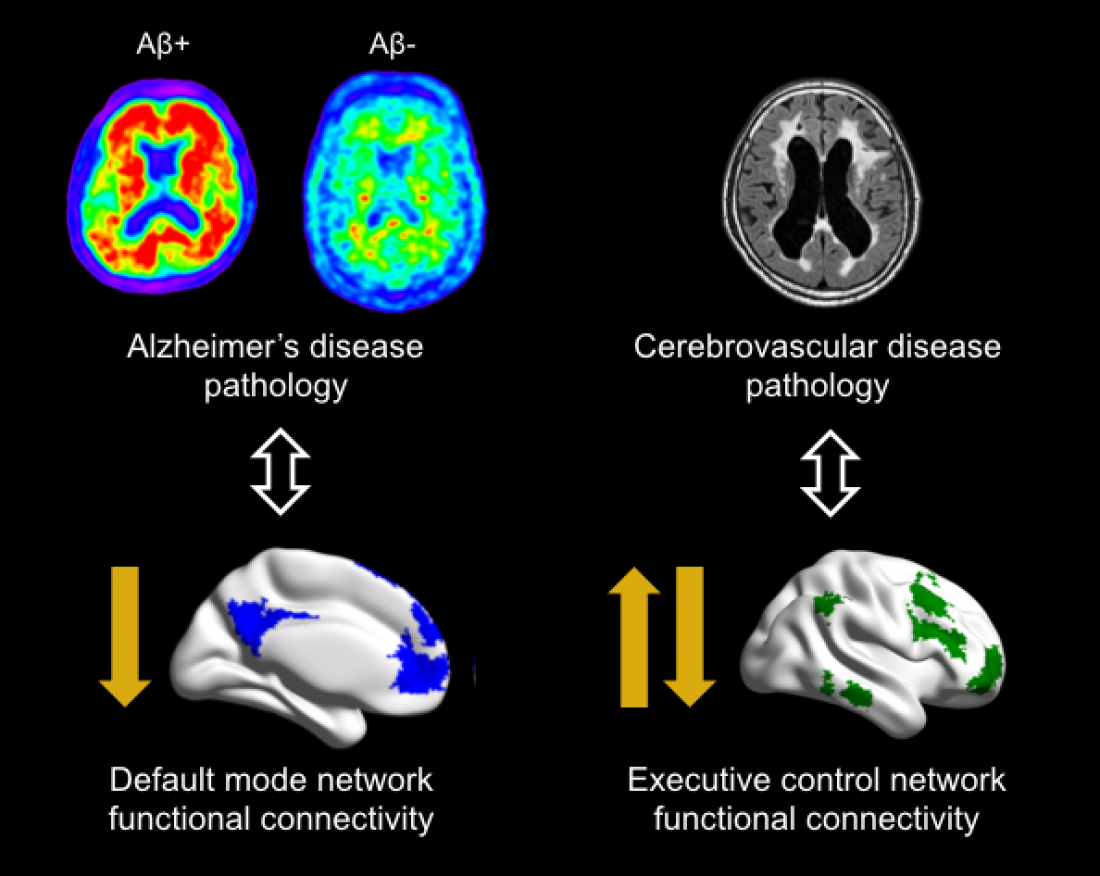Alzheimer’s disease and cerebrovascular disease pathologies exert differential effects on longitudinal changes in functional connectivity.
SINGAPORE, 17 September 2019 – People with mild cognitive impairment may undergo different changes in the brain based on the type of pathology they have, long before they develop dementia, according to a new study by scientists in Singapore and South Korea. These differences may help doctors better predict or differentiate whether the type of dementia they have is due to Alzheimer’s disease or cerebrovascular disease at an early stage.
A previous cross-sectional study conducted by the research team on a Singaporean cohort had suggested that Alzheimer’s disease and cerebrovascular disease have different effects on the functional connectivity – or communication among neurons – of various brain networks. Alzheimer’s disease is associated with reduced functional connectivity in the default mode network (DMN), which is linked to memory function. Cerebrovascular disease, on the other hand, is associated with disruptions in the executive control network (ECN), which is linked to executive function (such as attentional control, cognitive inhibition, working memory, and cognitive flexibility) and processing speed. No previous study has examined the associations between pathological markers of these diseases and longitudinal changes in the functional connectivity of these networks.
"Alzheimer’s disease frequently co-occurs with cerebrovascular disease, especially in Asia, where mixed dementia cases account for up to 50 per cent of dementia cases," explained Associate Professor Juan Helen Zhou, senior and corresponding author of the study, from the Neuroscience and Behavioural Disorders (NBD) Programme at Duke-NUS Medical School, Singapore. "Understanding the influence of co-occurring Alzheimer’s disease and cerebrovascular disease pathologies on brain functional connectivity networks may help doctors track early differential disease progression and predict future cognitive decline."
The study by Duke-NUS, in collaboration with researchers in South Korea from Sungkyunkwan University School of Medicine and Ulsan University School of Medicine, both located in Seoul, was published online in the journal Neurology. The research team recruited participants from Samsung Medical Center, at Sungkyunkwan University School of Medicine, that included people with mild cognitive impairment who suffered from symptoms such as memory problems, often considered an early sign of Alzheimer’s disease, and people with mild cognitive impairment with damage to small blood vessels in the brain, an early sign of vascular dementia, or dementia due to cerebrovascular disease.
The participants underwent positron emission tomography (PET) scans at the start of the study to see if they had amyloid-beta plaques in the brain that are associated with Alzheimer’s disease, and structural MRI scans to see if they had the signs of cerebrovascular disease associated with vascular dementia. Functional MRI (fMRI) scans were used to measure changes in brain functional network connectivity. These scans were repeated every year for up to four years.
The researchers found that the interactions in the DMN declined more steeply over time in the people who had amyloid-beta plaques in the brain than in people in early stages of vascular dementia and without amyloid-beta plaques in the brain. Specifically, the rate of annual decline in DMN connections was, on average, 13.6 times faster in the people with the Alzheimer’s disease marker than in those without.
Researchers also found that the rate of annual increase in interactions in the ECN was, on average, three times faster in people in the early stages of vascular dementia and without amyloid-beta plaques than in people in the early stages of Alzheimer’s disease.
“More studies are needed with larger numbers of participants and longer follow-up periods, but these results suggest that these changes in brain network connections could potentially be used to track early changes in Alzheimer’s disease and cerebrovascular disease,” said Associate Professor Sang Won Seo, a senior and corresponding author of the study from Samsung Medical Center.
“As populations age around the world, and particularly here in Singapore, where average life expectancy is highest at around 85 years, the disease burden from Alzheimer’s and vascular dementia will put more pressure on health resources. Early diagnosis of such diseases can go a long way in ensuring such resources are used most effectively,” commented Prof Patrick Casey, Senior Vice Dean for Research at Duke-NUS.
The researchers’ next step is to examine the additive and interactive effects of amyloid-beta, tau (another marker of Alzheimer’s disease), and specific types of cerebrovascular lesions on brain functional networks in cognitively normal and mild cognitive impairment individuals to facilitate prognosis and treatment planning.



